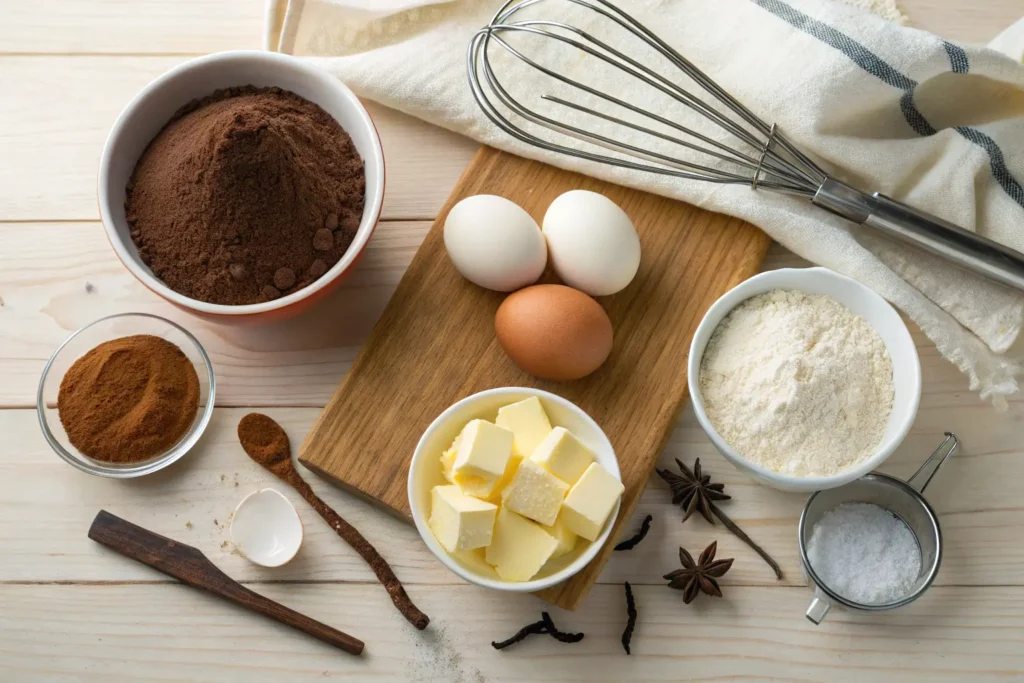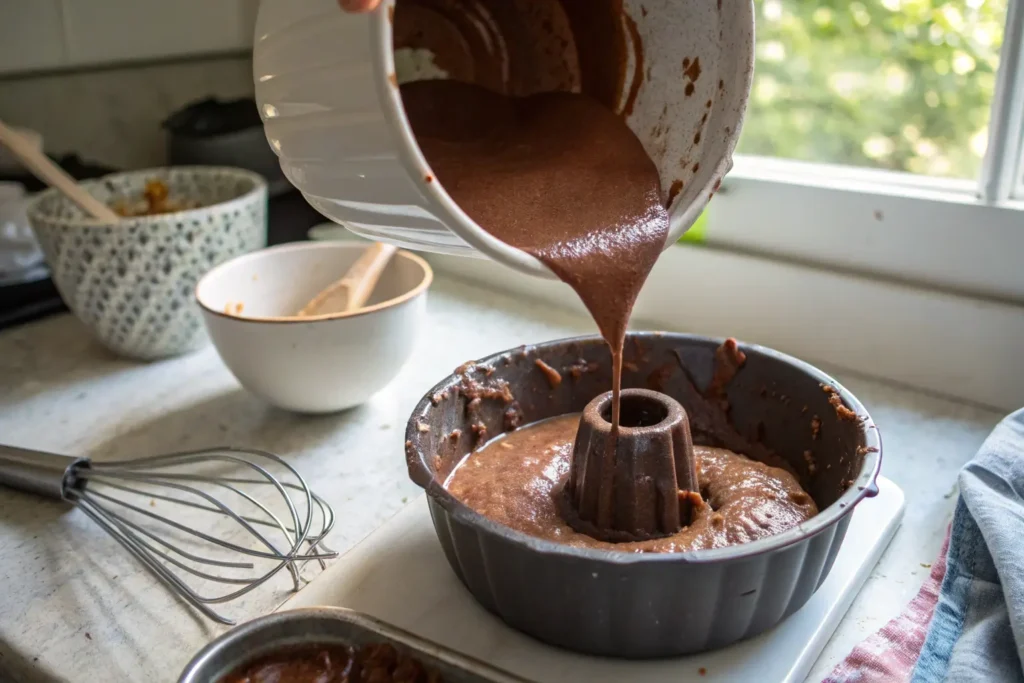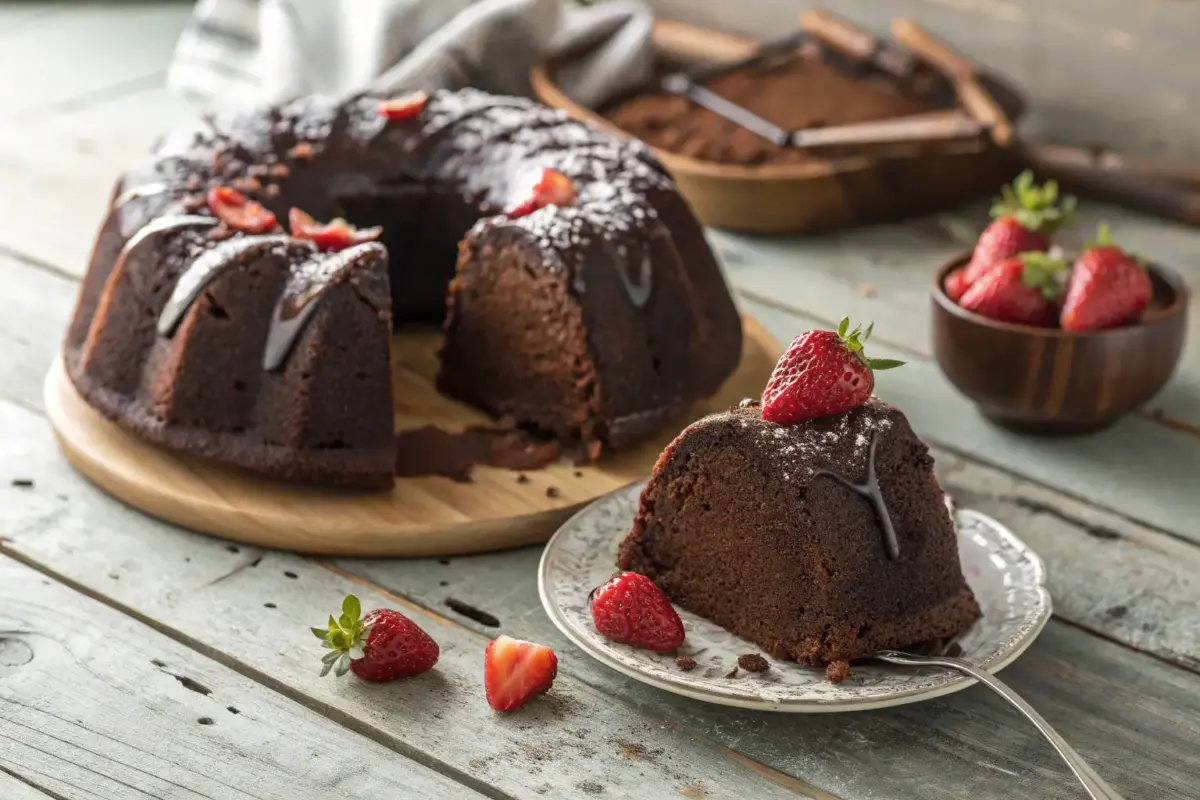Introduction to Chocolate Pound Cake Recipe
Let’s be honest—there’s something magical about chocolate pound cake. It’s rich, dense, and just the right amount of indulgent. Whether you’re baking for a family gathering, a celebration, or just to treat yourself, this cake always hits the spot. But before we dive into the details, let’s talk about why this dessert is so special.
Chocolate pound cake is more than just a treat; it’s comfort food with a touch of elegance. From its velvety texture to its deep, chocolatey flavor, every bite feels like a warm hug. If you’re ready to whip up the ultimate chocolate pound cake, let’s get started with the basics.
A Brief History of Pound Cake
Did you know the original pound cake recipe dates back to the 1700s? Back then, it was all about simplicity—equal parts butter, sugar, eggs, and flour. The result? A hefty, satisfying dessert (hence the name “pound”). Over the years, bakers started adding their own twists, including flavors like vanilla, lemon, and, of course, chocolate.
Today, pound cake has evolved into countless variations, but the chocolate version truly stands out. Why? Because it combines the classic richness of pound cake with the irresistible allure of cocoa. Talk about a winning combination!
Why Chocolate Pound Cake Stands Out
Okay, so what makes chocolate pound cake so special? For starters, it’s incredibly versatile. You can serve it plain, dress it up with a drizzle of ganache, or pair it with your favorite toppings like whipped cream and berries. Plus, it’s easy to make! With the right ingredients and a little bit of love, you can create a bakery-worthy dessert in your own kitchen.
Another reason chocolate pound cake shines is its texture. Unlike a traditional cake that’s light and airy, pound cake is dense yet moist. When you add chocolate to the mix, it becomes even more decadent. Trust me, once you try it, there’s no going back!
Essential Ingredients for Chocolate Pound Cake Recipe

Now that you know a bit about the history and charm of chocolate pound cake, it’s time to talk ingredients. The key to a great cake is using high-quality, fresh ingredients. Let’s break it down.
Choosing the Right Chocolate
Not all chocolate is created equal, folks. For a rich, chocolatey flavor, go for high-quality cocoa powder or melted dark chocolate. If you’re feeling fancy, you can even use a mix of both! Just make sure to avoid chocolate with too much sugar—it’ll throw off the balance of flavors.
Pro tip: Dutch-processed cocoa powder works wonders for a smoother, deeper flavor. It’s a bit pricier, but totally worth it if you want to take your cake to the next level.
Importance of High-Quality Butter and Shortening
Let’s talk fats—specifically butter and shortening. These two are the backbone of a great pound cake. Butter adds flavor and richness, while shortening helps create a tender crumb. The trick is finding the perfect balance between the two.
Always use unsalted butter so you can control the saltiness of your batter. And when it comes to shortening, go for a high-quality brand to avoid that greasy aftertaste. Trust me, your taste buds will thank you.
Additional Flavor Enhancers: Vanilla and Coffee
Vanilla extract might seem like a no-brainer, but don’t underestimate its power. A splash of good-quality vanilla brings out the chocolate’s natural sweetness. And here’s a little secret: adding a teaspoon of coffee or espresso powder can make your cake’s chocolate flavor pop. Don’t worry, it won’t taste like coffee—it just adds depth.
So, if you’ve got some instant coffee in your pantry, toss it in! You’ll be amazed at the difference it makes.
Equipment Needed for Baking Perfection
Alright, you’ve got your ingredients sorted. Now let’s talk tools. Having the right equipment can make or break your baking experience. Here’s what you’ll need.
Baking Pan Options: Bundt vs. Loaf
First up: your baking pan. The most common choices are a bundt pan or a loaf pan. Bundt pans give your cake a fancy, decorative look (perfect for parties), while loaf pans are great for a more classic, no-fuss presentation. Both work beautifully, so pick whichever one suits your vibe.
Just make sure to grease and flour your pan thoroughly. There’s nothing worse than a gorgeous cake getting stuck to the pan—trust me, I’ve been there.
Must-Have Tools for Consistent Results
Beyond the pan, a few other tools will make your life easier. A hand mixer or stand mixer is a must for creaming butter and sugar to perfection. A kitchen scale is also handy for measuring ingredients accurately—especially if you’re baking at high altitudes or experimenting with substitutions.
Other essentials include a rubber spatula for folding the batter, a whisk for combining dry ingredients, and a toothpick to test for doneness. Simple, right? These basics will set you up for success.
Step-by-Step Preparation of Chocolate Pound Cake Recipe

Once you’ve gathered your ingredients and tools, it’s time to get baking. Don’t worry; I’ll walk you through each step to make sure your chocolate pound cake turns out perfectly every time. Ready? Let’s do this!
Preparing the Ingredients For Chocolate Pound Cake Recipe
First things first, make sure all your ingredients are at room temperature. This includes your butter, eggs, and any dairy you’re using. Why? Because room-temperature ingredients mix together more evenly, giving you a smoother batter.
While you’re at it, preheat your oven to 325°F. This low and slow temperature helps your cake bake evenly without overbrowning. Don’t forget to grease and flour your pan—it’s a small step, but it makes a big difference when it’s time to release your cake.
Mixing Techniques for a Fluffy Batter
The secret to a light, fluffy pound cake lies in the mixing process. Start by creaming the butter and sugar together until it’s pale and fluffy. This step incorporates air into the batter, which helps with the cake’s texture.
Next, add your eggs one at a time, mixing well after each addition. If your batter starts to look a little curdled, don’t panic! That’s normal. Once your eggs are fully incorporated, alternate adding your dry ingredients (flour, cocoa powder, baking powder) and your wet ingredients (milk, vanilla, or coffee). Mix just until everything is combined—overmixing can make your cake dense.
Tips for Proper Layering and Folding
Here’s a pro tip: when adding chocolate chunks or chips to your batter, coat them in a bit of flour first. This prevents them from sinking to the bottom during baking. Gently fold them into the batter with a rubber spatula to keep everything evenly distributed.
Once your batter is ready, pour it into your prepared pan. Give the pan a few gentle taps on the counter to release any air bubbles. Trust me, this little step can save you from having those pesky air pockets in your finished cake.
Baking Tips for a Moist and Delicious Cake
Baking is where the magic happens, but it’s also where things can go wrong if you’re not careful. These tips will help you avoid common pitfalls and achieve a perfectly baked chocolate pound cake every time.
Understanding Oven Temperatures
Not all ovens are created equal. If you’ve ever had a cake turn out underbaked or overbaked, your oven might be to blame. Use an oven thermometer to check the actual temperature—it’s often different from what’s displayed on the dial.
Bake your chocolate pound cake on the middle rack for even heat distribution. If the top starts to brown too quickly, cover it loosely with foil. This little trick ensures a perfectly golden crust without burning.
The Role of Timing in Achieving the Perfect Texture
Timing is everything when it comes to baking. A chocolate pound cake typically takes about 60 to 70 minutes, but start checking for doneness around the 55-minute mark. Insert a toothpick into the center—if it comes out clean or with just a few moist crumbs, your cake is ready.
Resist the urge to open the oven door too often. Each time you do, the temperature drops, which can cause your cake to sink in the middle. Patience is key here!
Common Mistakes to Avoid
Even the best bakers make mistakes, but you can avoid some of the most common ones with these tips:
- Overmixing the batter: Once you add the flour, mix just until combined. Overmixing develops gluten, which can make your cake tough.
- Skipping ingredient measurements: Baking is a science. Use measuring cups for dry ingredients and a liquid measuring cup for wet ingredients to get the best results.
- Underbaking: If your cake isn’t fully baked, it’ll collapse as it cools. Use a toothpick to check for doneness and trust the process.
Cooling and Storing Chocolate Pound Cake Recipe
Your cake is out of the oven and smells amazing, but the work isn’t done yet. Cooling and storing your cake properly can make all the difference in its texture and flavor.
Proper Cooling Techniques to Preserve Moisture
Let your cake cool in the pan for about 10 minutes. This helps it firm up a bit, making it easier to remove. After that, turn it out onto a wire rack to cool completely. Avoid covering the cake while it’s still warm—it’ll trap steam and make the crust soggy.
If you’re short on time, you can speed up the cooling process by placing the wire rack in a cool, drafty spot. But remember, patience pays off when it comes to cake cooling.
How to Store Your Cake for Longevity
If you’re not eating your cake right away (and let’s be real, it’s hard to resist), store it properly to keep it fresh. Wrap it tightly in plastic wrap or place it in an airtight container. It’ll stay moist at room temperature for up to three days.
For longer storage, you can freeze your chocolate pound cake. Wrap it in plastic wrap, then foil, and freeze for up to three months. When you’re ready to enjoy it, let it thaw at room temperature. It’ll taste just as good as the day you baked it!
Creative Serving Ideas

Finally, let’s talk about serving your chocolate pound cake. Sure, it’s delicious on its own, but a few extra touches can take it to the next level.
Pairing with Ice Cream or Cream Sauces
A warm slice of chocolate pound cake paired with a scoop of vanilla ice cream? Yes, please! You can also drizzle your cake with a rich chocolate or caramel sauce for added decadence. It’s like a dessert dream come true.
Garnishing with Fresh Fruits and Nuts
For a pop of color and freshness, garnish your cake with sliced strawberries, raspberries, or even a sprinkle of pomegranate seeds. Chopped nuts, like almonds or pecans, add a nice crunch and complement the chocolate flavor beautifully.
With these serving ideas, your chocolate pound cake will be the star of any dessert table.
Variations and Twists on Chocolate Pound Cake
One of the best things about chocolate pound cake is how customizable it is. You can stick to the classic recipe or get creative with some fun variations. Let’s explore a few ideas that will keep your dessert game exciting.
Adding a Glaze or Ganache
If you want to take your cake up a notch, consider adding a glaze or ganache. A chocolate ganache made from equal parts heavy cream and dark chocolate adds a glossy, decadent finish. Simply pour it over your cooled cake and let it drip down the sides for a professional look.
Prefer something lighter? Try a simple powdered sugar glaze. Mix powdered sugar with a little milk or lemon juice until you get the desired consistency, then drizzle it over the cake. It’s quick, easy, and oh-so-delicious!
Experimenting with Marble or Mocha Swirls
For a fun twist, turn your chocolate pound cake into a marble cake. Set aside a portion of the batter and mix in a little vanilla extract. Swirl the vanilla batter into the chocolate batter using a knife or skewer for a beautiful marbled effect.
Want a coffee kick? Add a few teaspoons of espresso powder to part of the batter and create mocha swirls. It’s the perfect combo for coffee lovers—and pairs wonderfully with a cup of joe.
Healthier Alternatives for Chocolate Pound Cake Recipe
Craving chocolate pound cake but looking for healthier options? Don’t worry, I’ve got you covered. With a few ingredient swaps, you can enjoy this dessert with a little less guilt.
Substituting Ingredients for Lower Calories
To lighten things up, try replacing some of the butter with unsweetened applesauce or Greek yogurt. Both options reduce the fat content without compromising moisture. You can also swap out some of the sugar for a natural sweetener like honey or maple syrup.
Another tip? Use whole wheat pastry flour instead of all-purpose flour. It’s higher in fiber and still gives you a tender cake texture. Small changes like these can make a big difference!
Gluten-Free and Vegan Adjustments
Need a gluten-free option? Substitute the flour with a gluten-free baking blend that’s designed for cakes. Make sure it includes xanthan gum or another binder for the best results. You can also use almond flour for a nutty flavor, though the texture will be a bit denser.
For a vegan version, replace eggs with flax eggs (1 tablespoon ground flaxseed + 2.5 tablespoons water per egg). Use a plant-based butter alternative and almond or oat milk in place of dairy. You’ll end up with a cake that’s just as rich and satisfying as the original!
Troubleshooting Common Issues
Sometimes, despite your best efforts, things don’t go as planned. But don’t worry—here are some quick fixes for common chocolate pound cake problems.
Fixing Cracked Tops and Uneven Baking
If your cake develops a crack on top, don’t stress—it’s actually a hallmark of pound cakes! However, if the crack is too pronounced, it might be due to oven temperature. Double-check your oven with a thermometer and bake your cake in the center of the oven for even heat.
Uneven baking can also happen if your batter isn’t distributed evenly in the pan. Next time, use a spatula to level out the batter before baking. A little extra care goes a long way.
Remedies for Dry or Dense Cake
A dry cake usually means it was overbaked or didn’t have enough liquid in the batter. To fix this, you can brush your cake with a simple syrup (equal parts sugar and water, heated until dissolved). It’ll add moisture and a touch of sweetness.
If your cake turned out dense, it might be because the butter and sugar weren’t creamed properly, or the batter was overmixed. Next time, make sure to cream the butter and sugar until fluffy, and mix the batter just until combined after adding the flour.
Conclusion : Chocolate Pound Cake Recipe
And there you have it—everything you need to know to make, customize, and troubleshoot the perfect chocolate pound cake. Whether you’re a baking newbie or a seasoned pro, this dessert is sure to become a favorite in your repertoire.
From its rich, chocolatey flavor to its endless serving possibilities, chocolate pound cake is a treat that never disappoints. So go ahead, grab your ingredients, and get baking. Trust me, your taste buds will thank you!
Discover More Delicious Cakes!
Looking for your next baking adventure? Try our Churro Cheesecake recipe—it’s rich, indulgent, and perfect for any occasion. Happy baking!


1 thought on “Chocolate Pound Cake Recipe: 5 Creative Twists and Tips”